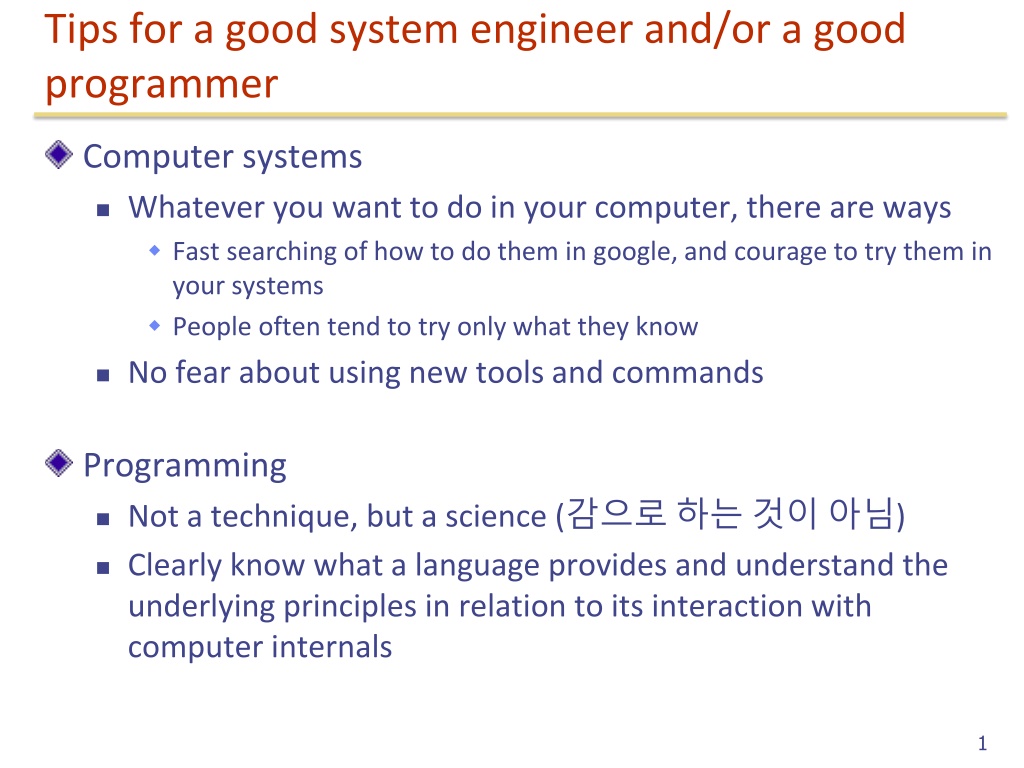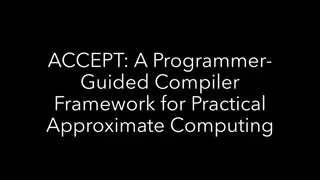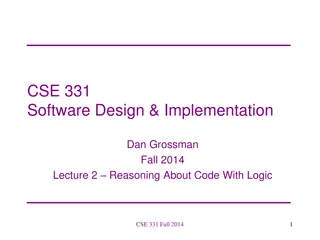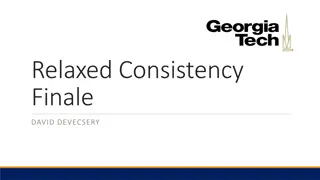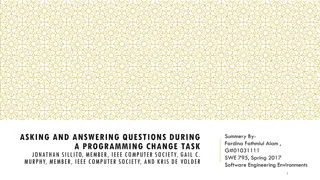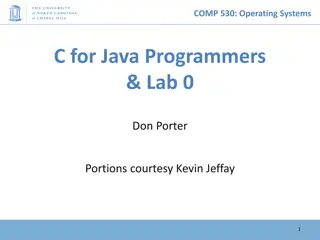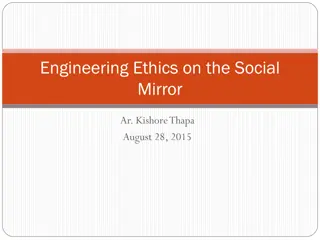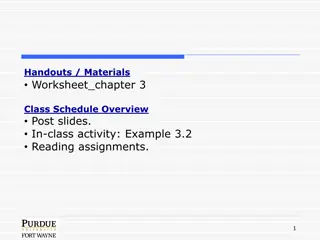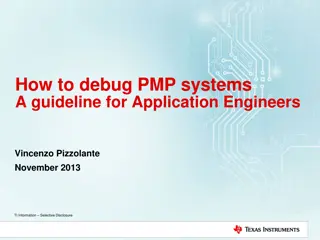Essential Tips for Successful System Engineers and Programmers
Valuable insights for aspiring system engineers and programmers include embracing new tools and commands, understanding programming as a science, mastering algorithms, evaluating their efficiency, and adopting experimental approaches to analyze running times accurately.
Download Presentation

Please find below an Image/Link to download the presentation.
The content on the website is provided AS IS for your information and personal use only. It may not be sold, licensed, or shared on other websites without obtaining consent from the author. Download presentation by click this link. If you encounter any issues during the download, it is possible that the publisher has removed the file from their server.
E N D
Presentation Transcript
Tips for a good system engineer and/or a good programmer Computer systems Whatever you want to do in your computer, there are ways Fast searching of how to do them in google, and courage to try them in your systems People often tend to try only what they know No fear about using new tools and commands Programming Not a technique, but a science ( ) Clearly know what a language provides and understand the underlying principles in relation to its interaction with computer internals 1
EE 205 Data Structure and Algorithms for Electrical Engineering Lecture 3. Analysis of Algorithms Yung Yi
Input Algorithm Output An algorithm is a step-by-step procedure for solving a problem in a finite amount of time.
What are we going to learn? Need to say that some algorithms are better than others Criteria for evaluation Structure of programs (simplicity, elegance, OO, etc.) Running time Memory space What else??? 4
Running Time (3.1) Most algorithms transform input objects into output objects. best case average case worst case The running time of an algorithm typically grows with the input size. 120 100 Running Time 80 Average-case running time is often difficult to determine. 60 40 Why? 20 We focus on the worst case running time. 0 1000 2000 Input Size 3000 4000 Easier to analyze Crucial to applications such as games, finance and robotics 5
Average Case vs. Worst Case The average case running time is harder to analyze because you need to know the probability distribution of the input. In certain apps (air traffic control, weapon systems,etc.), knowing the worst case time is important. 6
Experimental Approach Write a program implementing the algorithm 9000 8000 Run the program with inputs of varying size and composition 7000 6000 Time (ms) 5000 Use a wall clock to get an accurate measure of the actual running time 4000 3000 2000 1000 Plot the results 0 0 50 100 Input Size 7
Limitations of Experiments It is necessary to implement the algorithm, which may be difficult and often time-consuming Results may not be indicative of the running time on other inputs not included in the experiment. In order to compare two algorithms, the same hardware and software environments must be used Restrictions 8
Theoretical Analysis Uses a high-level description of the algorithm instead of an implementation Characterizes running time as a function of the input size, n. Takes into account all possible inputs Allows us to evaluate the speed of an algorithm independent of the hardware/software environment 9
The Random Access Machine (RAM) Model A CPU 012 A potentially unbounded bank of memory cells, each of which can hold an arbitrary number or character Memory cells are numbered and accessing any cell in memory takes unit time. 10
Pseudocode (4.2.3) High-level description of an algorithm Example: find the max element of an array More structured than english prose AlgorithmarrayMax(A, n) Input array A of n integers Output maximum element of A Less detailed than a program currentMax A[0] fori 1 ton 1 do ifA[i] currentMaxthen currentMax A[i] returncurrentMax Preferred notation for describing algorithms Hides program design issues 11
Pseudocode Details Control flow if then [else ] while do repeat until for do Method call var.method (arg [, arg ]) Return value returnexpression Expressions Assignment (like = in C, C++) = Equality testing (like == in C, C++) n2 Superscripts and other mathematical formatting allowed Indentation replaces braces Method declaration Algorithm method (arg [, arg ]) Input Output 12
Seven Important Functions (3.3) Seven functions that often appear in algorithm analysis: Constant 1 Logarithmic log n Linear n N-Log-N n log n Quadratic n2 Cubic n3 Exponential 2n 1E+30 1E+28 Cubic 1E+26 Quadratic 1E+24 1E+22 Linear 1E+20 1E+18 T (n ) 1E+16 1E+14 1E+12 1E+10 1E+8 In a log-log chart, the slope of the line corresponds to the growth rate of the function 1E+6 1E+4 1E+2 1E+0 1E+0 1E+2 1E+4 1E+6 1E+8 1E+10 n 13
Primitive Operations Basic computations performed by an algorithm Identifiable in pseudocode Largely independent from the programming language Exact definition not important (we will see why later) Assumed to take a constant amount of time in the RAM model Examples: Evaluating an expression Assigning a value to a variable Indexing into an array Calling a method Returning from a method 14
Counting Primitive Operations (3.4) By inspecting the pseudocode, we can determine the maximum number of primitive operations executed by an algorithm, as a function of the input size AlgorithmarrayMax(A, n) currentMax A[0] fori 1 ton 1 do ifA[i] currentMaxthen currentMax A[i] { increment counter i } returncurrentMax # operations 2 2n 2(n 1) 2(n 1) 2(n 1) 1 Total 8n 2 15
Estimating Running Time Algorithm arrayMax executes 8n 2 primitive operations in the worst case. Define: a = Time taken by the fastest primitive operation b = Time taken by the slowest primitive operation Let T(n) be worst-case time of arrayMax.Then a (8n 2) T(n) b(8n 2) Hence, the running time T(n) is bounded by two linear functions 16
Growth Rate of Running Time Changing the hardware/ software environment Affects T(n) by a constant factor, but Does not alter the growth rate of T(n) The linear growth rate of the running time T(n) is an intrinsic property of algorithm arrayMax 17
Constant Factors The growth rate is not affected by 1E+26 Quadratic Quadratic Linear Linear constant factors or 1E+24 1E+22 lower-order terms Examples 102n+ +105is a linear function 105n2+ + 108nis a quadratic function We consider when n is sufficiently large 1E+20 1E+18 1E+16 1E+14 T(n) 1E+12 1E+10 1E+8 1E+6 1E+4 1E+2 1E+0 We call this Asymptotic Analysis ( ) 1E+0 1E+2 1E+4 1E+6 1E+8 1E+10 n 18
Big-Oh Notation (4.2.3) Given functions f(n) and g(n), we say that f(n) is O(g(n)) if there are positive constants c and n0 such that f(n) cg(n) for n n0 Example: 2n+10 is O(n) 2n+10 cn (c 2) n 10 n 10 (c 2) Pick c = 3 and n0 = 10 10,000 3n 2n+10 1,000 n 100 10 1 1 10 100 1,000 n 19
Big-Oh Example Example: the function n2 is not O(n) n2 cn n c 1,000,000 n^2 100n 10n n 100,000 The above inequality cannot be satisfied since c must be a constant 10,000 1,000 100 10 1 1 10 100 1,000 n 20
More Big Oh Examples 7n-2 7n-2 is O(n) need c > 0 and n0 1 such that 7n-2 c n for n n0 this is true for c = 7 and n0 = 1 3n3 + 20n2 + 5 3n3 + 20n2 + 5 is O(n3) need c > 0 and n0 1 such that 3n3 + 20n2 + 5 c n3 for n n0 this is true for c = 4 and n0 = 21 3 log n + 5 3 log n + 5 is O(log n) need c > 0 and n0 1 such that 3 log n + 5 c log n for n n0 this is true for c = 8 and n0 = 2 (Question) 3 log n + 5 is O(n)? Yes or No? 21
Big-Oh and Growth Rate The big-Oh notation gives an upper bound on the growth rate of a function The statement f(n) is O(g(n)) means that the growth rate of f(n) is no more than the growth rate of g(n) We can use the big-Oh notation to rank functions according to their growth rate Which is possible? f(n) is O(g(n)) g(n) is O(f(n)) g(n) grows faster f(n) grows faster Same growth Yes No Yes No Yes Yes 22
Big-Oh Rules If is f(n) a polynomial of degree d, then f(n) is O(nd), i.e., 1. Drop lower-order terms 2. Drop constant factors Use the smallest possible class of functions Say 2n is O(n) instead of 2n is O(n2) Use the simplest expression of the class Say 3n+5 is O(n) instead of 3n+5 is O(3n) 23
Asymptotic Algorithm Analysis The asymptotic analysis of an algorithm determines the running time in big-Oh notation To perform the asymptotic analysis We find the worst-case number of primitive operations executed as a function of the input size We express this function with big-Oh notation Example: We determine that algorithm arrayMax executes at most 8n 2 primitive operations We say that algorithm arrayMax runs in O(n) time Since constant factors and lower-order terms are eventually dropped anyhow, we can disregard them when counting primitive operations 24
Computing Prefix Averages We further illustrate asymptotic analysis with two algorithms for prefix averages 35 X A 30 The i-th prefix average of an array X is average of the first (i+ 1) elements of X: A[i]= (X[0] +X[1] + +X[i])/(i+1) 25 20 15 10 Computing the array A of prefix averages of another array X has applications to financial analysis 5 0 0 1 2 3 4 5 6 1 2 3 4 5 6 7 25
Prefix Averages (Quadratic) The following algorithm computes prefix averages in quadratic time by applying the definition AlgorithmprefixAverages1(X, n) Input array X of n integers Output array A of prefix averages of X A new array of n integers fori 0 ton 1 do s X[0] forj 1 toido s s+X[j] A[i] s (i+ 1) returnA #operations n n n 1 + 2 + + (n 1) 1 + 2 + + (n 1) n 1 26
Arithmetic Progression The running time of prefixAverages1 is O(1 + 2 + + n) 7 6 5 The sum of the first n integers is n(n+ 1) 2 4 There is a simple visual proof of this fact 3 2 1 Thus, algorithm prefixAverages1 runs in O(n2) time 0 1 2 3 4 5 6 27
Prefix Averages (Linear) The following algorithm computes prefix averages in linear time by keeping a running sum AlgorithmprefixAverages2(X, n) Input array X of n integers Output array A of prefix averages of X #operations A new array of n integers s 0 fori 0 ton 1 do s s+X[i] A[i] s (i+ 1) returnA n 1 n n n 1 Algorithm prefixAverages2 runs in O(n) time 28
Another Example Result 0; m 1; for I 1 to n m m*2; for j 1 to m do result result + i*m*j 29
Math you need to review properties of logarithms: logb(xy) = logbx + logby logb (x/y) = logbx - logby logbxa = alogbx logba = logxa/logxb Summations Logarithms and Exponents properties of exponentials: a(b+c) = aba c abc = (ab)c ab /ac = a(b-c) b = a logab bc = a c*logab Proof techniques Basic probability For randomized algorithms (later in this course) 30
Relatives of Big-Oh big-Omega f(n) is (g(n)) if there is a constant c > 0 and an integer constant n0 1 such that f(n) c g(n) for n n0 big-Theta f(n) is (g(n)) if there are constants c > 0 and c > 0 and an integer constant n0 1 such that c g(n) f(n) c g(n) for n n0 31
Intuition for Asymptotic Notation Big-Oh f(n) is O(g(n)) if f(n) is asymptotically less than or equal to g(n) big-Omega f(n) is (g(n)) if f(n) is asymptotically greater than or equal to g(n) big-Theta f(n) is (g(n)) if f(n) is asymptotically equal to g(n) 32
Examples (1) 5n2 is (n2) f(n) is (g(n)) if there is a constant c > 0 and an integer constant n0 1 such that f(n) c g(n) for n n0 let c = 5 and n0 = 1 5n2 is (n) f(n) is (g(n)) if there is a constant c > 0 and an integer constant n0 1 such that f(n) c g(n) for n n0 let c = 1 and n0 = 1 33
Examples (2) 5n2 is (n2) f(n) is (g(n)) if it is (n2) and O(n2). we have already seen the former, for the latter (for O(n2))recall that f(n) is O(g(n)) if there is a constant c > 0 and an integer constant n0 1 such that f(n) < c g(n) for n n0 Let c = 5 and n0 = 1 34
What do we want for our algorithms? Prof. Yung Yi A graduate student What is the order of your algorithm? Answer: nlogn, n2, n3, 2n Polynomial order Generally fine. Try to reduce the running time if above or equal to n3 There are some problems for which there does NOT exist any polynomial-time algorithm (up to so far) We say that they NP-hard or NP-complete You will learn formalism for this in the algorithm class 35
